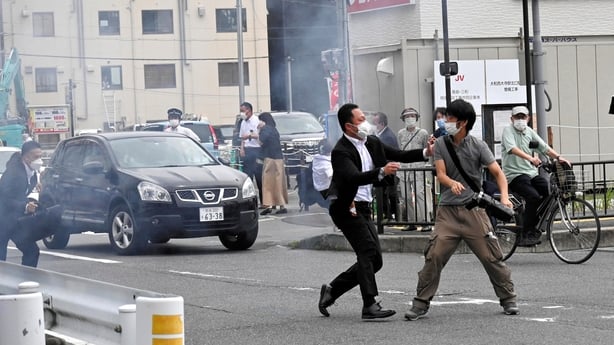The suspected killer of Japan's former prime minister Shinzo Abe admitted targeting the politician and said he held a grudge against an organisation he believed Mr Abe was connected to, police have said.
Senior police officers in the western region of Nara, where the murder took place, named the suspect as unemployed 41-year-old Tetsuya Yamagami, who said he had used a handmade gun.
"That's the suspect's assertion, and we have determined that (the gun) is clearly handmade in appearance, although our analysis is currently ongoing," an officer told reporters.
Police declined to give details of the "particular organisation" mentioned by the suspect, saying investigations were ongoing, but several Japanese media outlets described it as a religious group.
"The suspect stated that he held a grudge against a particular organisation, and that he committed the crime because he believed former prime minister Abe had a connection to it," a senior police officer in Japan's Nara region told reporters, declining to give further details.
Japanese public broadcaster NHK said Mr Yamagami told police after his arrest that he "was frustrated with the former prime minister and targeted Abe with the intention of killing him".
Mr Yamagami was pictured at the scene holding a large boxy black object that appeared to have two barrels.

Officers in protective gear began searching the suspect's home after 5pm and have confiscated "several handmade gun-like items".
The suspect, who addressed police in a "matter-of-fact way", told officers he had worked for the Maritime Self-Defense Force - Japan's navy - for three years from 2002, but these details are also under investigation.
Mr Yamagami also told police he had learned about Mr Abe's visit online, the officers said.
They added that they were probing whether there were any problems with security at the campaign event where the assassination took place.
"We will take appropriate measures if problems were discovered."
What happened?
The attack came before noon in the country's western region of Nara, where Mr Abe, 67, had been delivering a stump speech with security present, but spectators able to approach him easily.
At about 11.30am local time footage broadcast by NHK showed him standing on a stage when a man dressed in a grey shirt and brown trousers begins approaching from behind, before drawing something from a bag and firing.
At least two shots appear to be fired, each producing a cloud of smoke.
As spectators and reporters ducked, a man was shown being tackled to the ground by security. He was later arrested on suspicion of attempted murder.
Where did Abe die?
Mr Abe was taken to Nara Medical University Hospital for treatment, with national broadcaster NHK saying he was able to speak in the minutes after the attack but subsequently lost consciousness.
He was pronounced dead by the hospital in the afternoon.
"Shinzo Abe was transported to (the hospital) at 12:20 pm. He was in a state of cardiac arrest upon arrival. Resuscitation was administered. However, unfortunately he died at 5.03pm," said Hidetada Fukushima, the hospital's professor of emergency medicine.
Mr Abe suffered a gunshot wound to the right side of his neck, NHK reported. Local officials declined to confirm details of his injury.
Mr Abe was married to Akie Abe, 60, the daughter of a wealthy business family. The pair do not have children.

